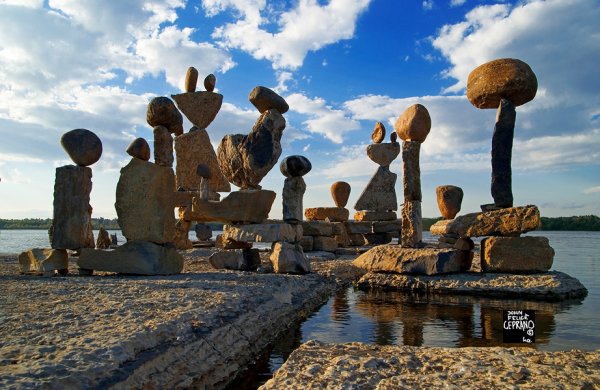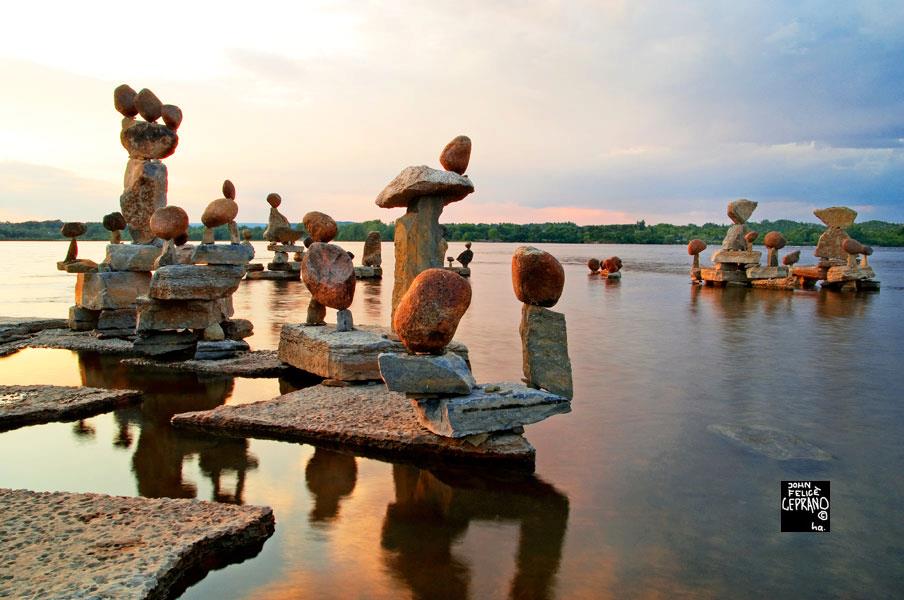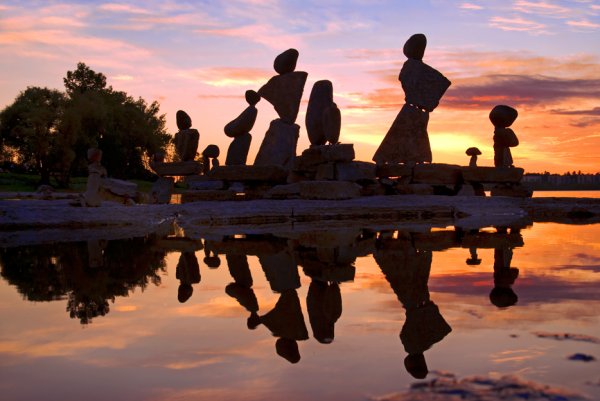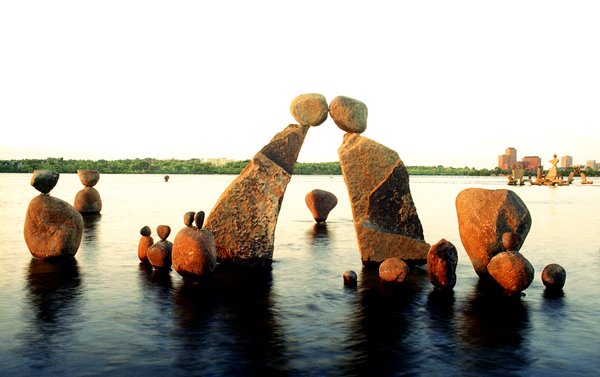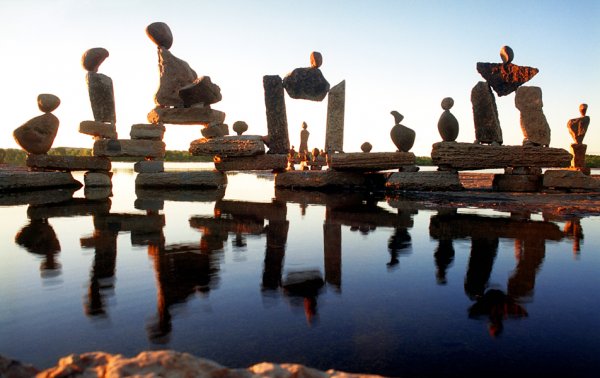Here’s a guy who was playing with rocks before I learned to read. John Ceprano continues to channel much of his passion into a continuously evolving sculpture park with the indigenous limestone at Remic Rapids, Ottawa, Canada. I had the privilege of experiencing the site, working with the rocks, and meeting several amazing people including John at BAWI: Ottawa back in August of 2012. There is a lot of history at Remic Rapids and the site has a slightly mysterious sense of magic. Based on my experience there, John’s efforts have positively affected countless people in the Ottawa area… I met several regular visitors who loved visiting the site to find stillness….
Something about John’s balance style that has trickled into some of my own work is the foundations he creates for his larger works… Some of the larger rocks in his pictures are HUGE and extremely heavy. However, they do a great job of defining the open space. The trick is being more careful. John, like many other rock balancers, has his share of “battle scars” from working with the heavy and sharp limestone.
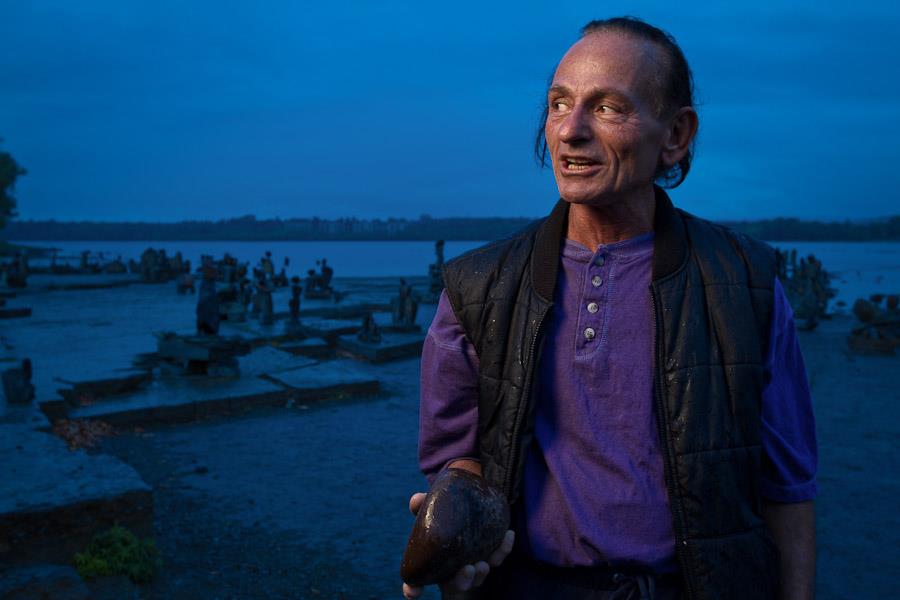
***All photos in this post are under copyright and ownership of John Ceprano and require permission for use.
Q&A
GG: How long have you been practicing stone balance? Where do you normally practice?
Hi Michael, thank you for this opportunity to share some personal insight on the art of stone balance. The balanced rock sculptures began innocently on the Ottawa River, at the Remic Rapids Park in 1986, and I have returned to the site each year since. A 1989 Canada Council grant plus government support since 2000, has helped promote the art form.
GG: Please describe your first experience rock balancing. How did you first discover the art?
The first day was simply enjoying the sound of the rapids with no attention to the rocks. However, when I returned a week later, the river had receded significantly, exposing an amazing variety of rocks and curiosity. The first experience was a simple linear installation of rocks on the limestone riverbed, redirecting the flow of water into patterns; balance was not the first attention. The first attention was water; followed by rock, which created the third, balance. It was entirely without thought or intention.
GG: Please identify one or more stone balance artists (if any) that inspired you initially and/or along your journey, and have contributed to your own style/interest/development with the art.
Inspiration for stone balance art came directly from nature. I had no awareness of rock balance art, but land art was an area of interest after discovering Christo around 1970. Later, Andy Goldsworthy, Richard Serra, and Isamu Noguchi all inspired some direction in the processing of the art form.
BAWI, the first International Stone Balance Festival, Ancona, Italy, 2012, was the first personal interactive experience that provided enormous inspiration. Being with other artists, sharing information and spirit, had a powerful impact, and the 2012 installation at Remic Rapids is a testimony to that experience, which also inspired the second BAWI here in Ottawa, also in 2012.
GG: Do you feel a spiritual dimension to the practice? How has stone balance improved your life/ approach to life/ general well being?
I prefer the word “magical!” I never know what I am doing until I am done, and every experience is a surprise. I refer to it as a “healing place”.
GG: Do you think stone balance has therapeutic and/or academic applications? please explain.
Balance is a therapy, and having worked as a rehabilitation nurse, I know balance is essential to healing, both physically and mentally.
The academic applications include “on site” workshops at Remic Rapids each summer, plus workshops within the educational system. Additionally, there are the lectures to organizations, such as social agencies, gardening and landscape providers, etc.
GG: Please offer some insight, if any, into how or why stone balance appears as a GLOBAL practice, despite geographic or cultural isolation.
The Hopi use the term “Koyaanisqatsi”, or “life out of balance”, it is not a new term. As a species, we are constantly seeking balance, consciously or innocently according to our nature. However, why rocks? Perhaps it is the availability, but I imagine it may be different for each person.
GG: Lastly, please offer any comments/advice (if any) for beginners.
Seek joy; not comfort.

